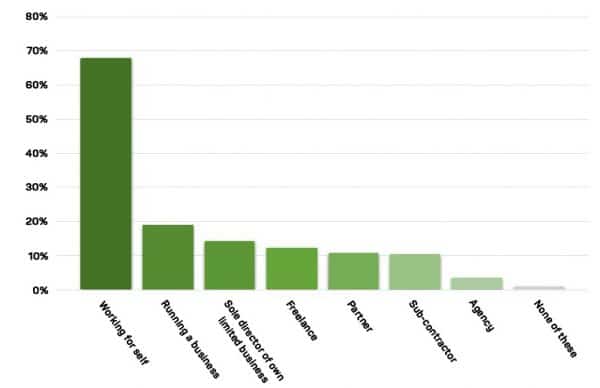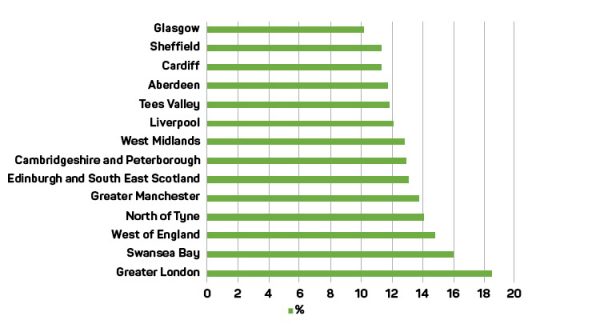
The most popular industries and cities to be self-employed in
Posted on 9th April 2021 by Katherine Ducie
Nearly 4.4 million people in the UK are currently self-employed, representing 15.3% of employment, a steady increase of 1.2 million since the end of 2000 [1].
Self-employment in the UK was at its highest at the start of 2020, when over 5 million people were self-employed. Following the coronavirus pandemic, self-employment in the UK has fallen to levels not seen since 2015, yet despite this, self-employment in some industries continues to rise [1].
The self-employed make a significant contribution to the UK’s economic output and while some industries are still dealing with the impact of COVID-19, the flexibility and work efficiency of the self-employed will no doubt have a big part to play in the economy’s recovery.
In this blog, we will look at some interesting statistics on self-employment in the UK, including:
- The most popular industries to be self-employed in right now
- Types of self-employed individuals
- Self-employment by gender
- Self-employment by city region
Number of self-employed people in the UK by industry
| Industry | Number of self-employed people |
| Construction | 811,000 |
| Professional scientific & technical activities | 602,000 |
| Human health & social work activities | 342,000 |
| Wholesale, retail & repair of motor vehicles | 334,000 |
| Administration & support services | 319,000 |
| Education | 283,000 |
| Transport & storage | 264,000 |
| Information & communication | 236,000 |
| Manufacturing | 199,000 |
| Agriculture, forestry, fishing, mining, energy & water | 191,000 |
| Accommodation & food services | 107,000 |
| Financial & insurance activities | 101,000 |
| Real estate activities | 63,000 |
| Public admin & defence | 52,000 |
Source: Statista
With 811,000 self-employed workers, Construction in the UK is the most popular industry for the self-employed, followed by 602,000 self-employed people working in professional, scientific and technical roles and 342,000 in human health and social work activities, as of the 3rd quarter of 2020.
Types of self-employed individuals

Source: Office for National Statistics
Research by the Office for National Statistics shows that “Working for yourself” is the most common type of self-employment [2], with over two-thirds reporting that they work for themselves.
19% say they run a business while 15% are the sole director of their own limited company.
12% identify as freelancers while 11% report being partners and a further 10% describe themselves as being a sub-contractor.
(As self-employed individuals may identify as being in more than one category, the total of these results does not equal 100%.)
The self-employed by gender
Statistics from 2019 showed that 66% (two thirds) of self-employed people were men – 3.3 million men in total, while 1.7 million women were self-employed.
Over 25% of self-employed men work in the construction industry while 15% of self-employed women work in the health and social work industry, followed by 14% working in professional, scientific and technical roles.
The top five groups for self-employed men include:
| Occupation | Number of self-employed men |
| Construction and building trades | 481,000 |
| Road transport drivers | 292,000 |
| Agricultural and related trades | 197,000 |
| Artistic, literary and media occupations | 171,000 |
| Managers and proprietors in other services | 160,000 |
Source: Office for National Statistics
The top five groups for self-employed women include:
| Occupation | Number of self-employed women |
| Artistic, literary and media occupations | 136,500 |
| Hairdressers and related services | 132,000 |
| Managers and proprietors in other services | 109,000 |
| Elementary cleaning occupations | 109,000 |
| Teaching and educational professionals | 91,000 |
Source: Office for National Statistics
Self-employment by regions
Unsurprisingly, the city region with the most self-employed people is Greater London followed by Swansea Bay City Region and consequently the West of England.
Percentage of self-employed people by city regions (in 2019):

Source: Office for National Statistics
For more information on how you can stay protected with Freelance Insurance, call our friendly team of experts today on 0333 321 1403, or click to get a quick online quote in minutes!
CLICK HERE FOR A QUICK ONLINE BUSINESS INSURANCE QUOTE
Related articles:
Why employing freelancers boosts business productivity, profit and employment growth
5 ways to reduce your tax bill when self-employed
Sources:
(1) https://www.statista.com/statistics/318234/united-kingdom-self-employed/
(2)https://www.ons.gov.uk/employmentandlabourmarket/peopleinwork/employmentandemployeetypes/articles/coronavirusandselfemploymentintheuk/2020-04-24
https://www.statista.com/statistics/318406/united-kingdom-self-employed-type-of-work-industry-section/
Useful Links

Professional Indemnity Insurance
Protects against claims of alleged negligence in your professional services, advice and designs.

Public Liability Insurance
Protects against claims of injury to third-parties or damage to a third-party's property.

Cyber Insurance
Covers your business in the event of a malicious attack on your computer systems and data.
